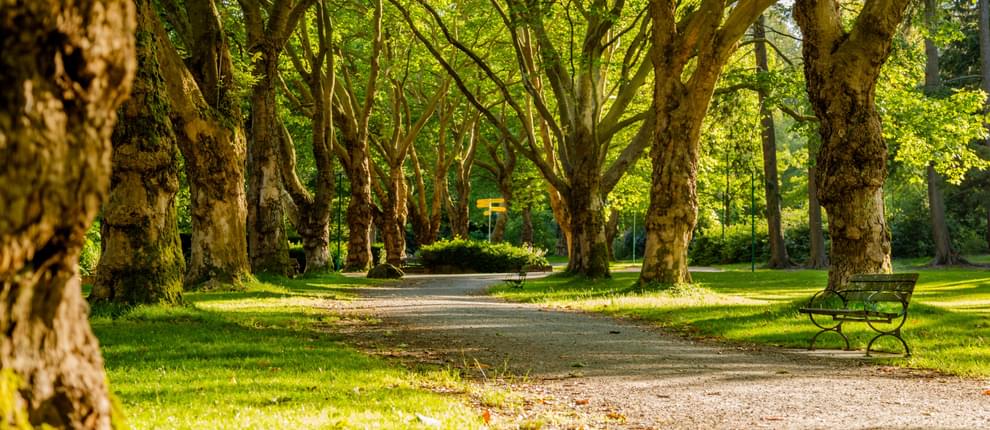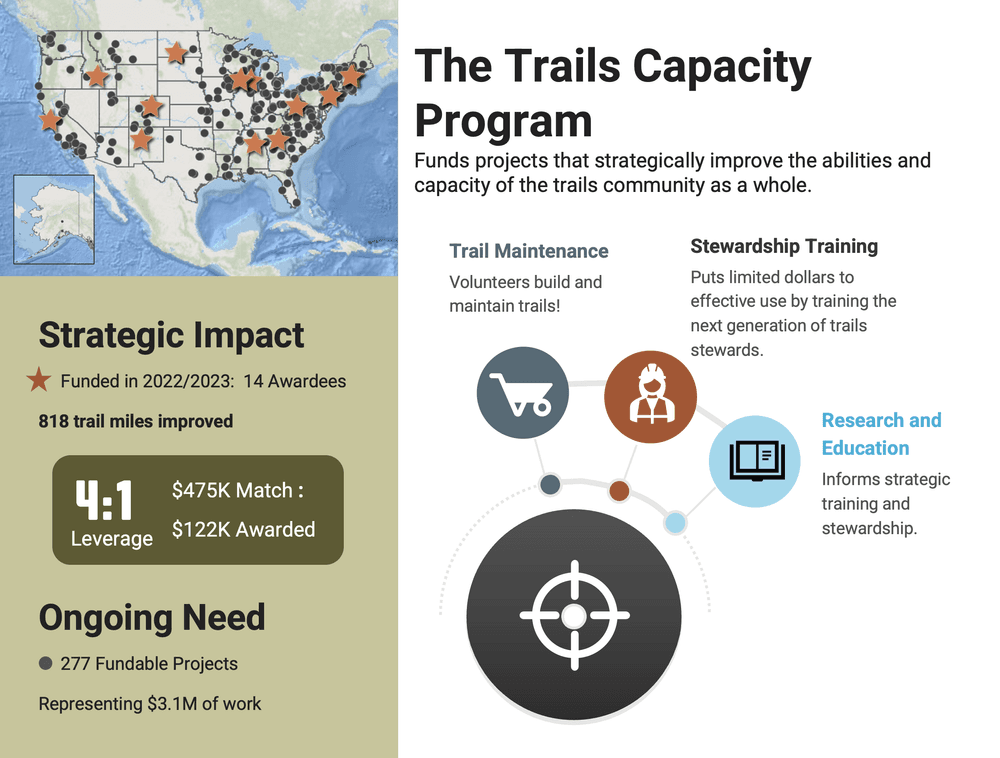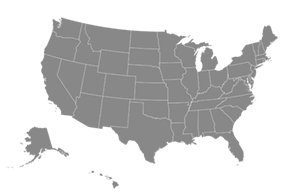




The Trail Fund is a joint initiative of the Trails Move People Coalition, led by American Trails.
The Trails Capacity Program funds projects across the nation that strategically improve the abilities and capacity of the trails community as a whole.
America's trails suffer from a trail maintenance backlog which is exacerbated by increased use, extreme weather and a diminishing pool of skilled trail professionals and volunteers. Addressing trail maintenance needs across the country starts with training and informing the next generation of trail stewards, and understanding where grant dollars can do the most good. This grant program targets available funding toward supporting small local trail projects that engage the community and connect trail assets to a broader spectrum of users. We find the best trail partners and we measure our success in terms of visible, on-the-ground maintenance of trails and increased capacity of organizations and trail stewards to do the job effectively.

On this page:
The Trails Capacity Program supports partners from all nonmotorized and motorized trail user groups, including water trails. Projects may include trail research, stewardship, and maintenance projects that are inclusive, engaging, educational, and foster improved trail user behavior. This program is targeted for all federal public lands, as well as state, local, and private lands accessible to the general public. Projects on Forest Service lands will not be disqualified, but applicants should consider whether the Legacy Trails Grant Program may be more appropriate.
Background
The Trails Capacity Program launched in 2022 with a generous gift of $50,000 from the Ford Corporation, plus additional funding in smaller amounts from individuals from the trails community. With this gift, Ford, through the Bronco Wild Fund made clear its commitment to support all trail users across the country and ensure that high-quality trails are available to all. In early 2023 American Trails received an additional $75,000 in 2022 end-of-year funding from Bronco Wild Fund. Also in 2023, Maverik and Conservation United joined as Program supporters. We are very grateful to our corporate and individual donors and continue to accept sponsorships and donations.
The Trails Capacity Program is open to applications for projects on public or private land across the country. These grants are for work on motorized or nonmotorized trails/project that are open to the public anywhere in the United States and Puerto Rico. We will focus our funding on state and local lands, and projects on federal lands will be accepted. For trails located on US Forest Service land we suggest you consider applying to the Legacy Trails Program, which focuses on funding USFS trails exclusively.
To get a sense of the types of projects this program has funded, View the awarded projects for 2023 and the awarded projects for 2022, or explore the map below to find out more about awarded and non-awarded projects.
Black Dot = 2022 Non-awardees
Orange Star = 2022 Awardees
Red Star = 2023 Awardees
The goals of this program are to uphold the American Trails mission, vision, core values, guiding principles, and the following:
Priority #1: Stewardship Training
Research informs us how to effectively engage trail stewards on public lands. By focusing on engaging younger, under-served, and diverse populations as active trail stewards, we can build a force of passionate individuals to tackle our nation’s trail maintenance needs.
The goal of developing high quality, consistent training opportunities is to preserve skills that have been developed over decades as well as teaching the newest technology. Top quality and readily accessible training will help all of us perform to the best of our abilities.
Priority #2: Trail Maintenance Backlog on State and Local Lands
Unfortunately, trails do not receive the ongoing maintenance support that they need through the Federal, State, and local appropriations process, resulting in a huge trail maintenance backlog. By current estimates in the US Forest Service alone, if nothing were to change in the current appropriations for trail maintenance, it would take over one thousand years to eliminate the current trail maintenance backlog. And that does not even take into consideration the additional miles of trail that will be added to the backlog in that same time.
Maintenance is not easy to fund, but it is critical in helping our country, our citizens, and our communities maintain their connection to nature and to the enjoyment of our country’s most beautiful landscapes.
Priority #3: Research and Education
The trails community is witnessing unprecedented growth and a shift in leadership away from federal agencies, toward foundation and private investment driving trail development. Research and data on trails are critical to show the impact and benefits of trails. Our research goal is to focus on understanding how trails increase the capacity of the trails community to serve the public at the community, state, and federal levels.
With solid data, we can articulate this value and impact to public leaders, the outdoor industry, and other industries that benefit from trails. Please see Jeffrey Marion’s white paper A Call for Expanding Trails Research for ideas on research topics.
What are the Program’s parameters for making grants?
Trails Capacity Program grants range from $5,000 minimum to a maximum of $10,000 for the purposes described above.
What trail types are eligible for funding?
The Trails Capacity Program supports trails that serve ALL types of trail users, motorized and nonmotorized. This includes hiking, cycling, mountain biking, trail running, access routes, horseback riding, water trails, ATVs, snowmobiling, and more.
What types of organizations are eligible for funding?
Will this program award grants to fiscal sponsors on behalf of applicants who are not eligible as 501(c)(3) non-profit organizations?
Yes, provided the fiscal sponsor meets our eligibility criteria. The grant application must be completed by the fiscal sponsor, who will provide all information required, in addition to including supplemental information on the sponsored applicant and the proposed project or program.
What is ineligible for funding?
What are indirect costs vs. direct costs?
Indirect costs are general business expenses that keep you operating. They represent the expenses of running your organization and doing your work that are not readily identified with a particular project or grant award, such as utilities, rent on office space, phones or non-project specific equipment rental, and other intangible overhead costs.
Direct costs are expenses that directly go into providing services. A tangible purchase such as hand tools could be shown as an in-kind matching cost for your project.
Applicants are allowed to budget for up to 10% indirect costs.
Can this funding be used to hire staff, or pay for staff time?
Yes, hiring or supplementing staff or contractor payroll is eligible if the funded portion of the staff's duties directly involves maintenance of trails, training of stewards, or research programs.
Can this funding be used to hire someone to mow the lawn, so others have time to work on trails?
We can’t guarantee that a proposal such as this would end up ranking as high as other submissions which are more aligned with the program goals and priorities.
The goal is for funds to directly support the proposed trails project.
Can this funding be used for wayfinding or interpretive signage?
If this project involves replacing existing signage, it may qualify as part of a maintenance project, as long as the condition of the signs can be documented. Alternatively, the purchase of new signage may count as an in-kind match for your project.
Can this funding be used for adding to our maintenance endowment fund?
No. The goal is for funds to be spent directly on implementing a proposed trails stewardship training, maintenance and/or research project.
Can this funding be used for putting in a culvert?
This program cannot fund new construction. Replacing a culvert under a trail that is in need of maintenance may qualify as part of a larger trail maintenance project.
Is purchasing an enclosed trailer to transport our mowers and other equipment to the various trail locations a reasonable request for a grant?
This could be a reasonable request, as long as your application makes the case in terms of how this additional equipment will directly affect the capacity of your organization to complete trail maintenance and quantify the anticipated increase in trail mileage maintained.
Are projects involving stewardship training, maintenance, and research ok?
Yes! Projects that include more than one grant program priority of stewardship training, maintenance, and research may be ranked higher than those meeting only one priority.
Is a project on an unpaved road eligible?
Generally, a road would not be eligible for this grant program. However, this program funds maintenance of recreational trails for both nonmotorized and motorized recreational trail uses. For example, a 4-wheel drive club may use unpaved roads as the primary source of recreational access. If you can make a case that a road is primarily used for recreational access, and that maintenance and stewardship training would improve recreational opportunities and capacity for your constituency, then our review committee would consider that eligible for consideration.
Can my organization apply to the Capacity Program if we have already submitted a Legacy Trails application for the 2024/25 season?
Yes, you are eligible to apply, even if you have active Legacy Trail Program projects. When projects are on USFS lands, we generally try to funnel those projects into the Legacy Trail Program, since there is much more money available in that program. It does not technically make you ineligible to propose projects on USFS lands for the Trail Capacity Program, however, it is likely to make your project a bit less competitive in the selection process.
Can the fund help pay for a detailed plan for the overhaul of a blown-out trail?
This grant program targets available funding toward visible, on-the-ground maintenance of trails and increased capacity of organizations and trail stewards to do the job effectively. Although those proposing trails planning projects are welcome to apply, the project evaluators may not rank it as high as those that are focused on hands-on trail maintenance, stewardship training and/or research.
Would this grant cover CPR and AED training? Yes, the Trails Capacity Program funds stewardship training so CPR and AED training would qualify. An application would be most competitive if this training is part of a larger trails stewardship training project.
Can you work with me to figure out what type/scope of project to submit? Unfortunately, we have a very small staff and do not have the capacity to work with potential grant applicants to help you craft your specific project scope.
How often does this program review grant applications?
Currently, we review grant applications annually. Please subscribe to our email list to be the first to be notified when the application window opens each year.
When are grants funded?
Grants will be funded in full via direct deposit within two weeks following the announcement of the award.
Are there restrictions on the length of time needed to complete projects or programs funded by grants?
Projects funded by the Trails Capacity Program must be completed by December 31 of the award year.
Do awarded organizations need to provide a report following completion of their project?
If you’re awarded a grant, you’ll be required to share an interim report on the specific intended outcomes of the grant and the progress made in delivering on them.
Funded projects will also need to provide a final report (including photos) following completion of the project and use of the funding provided by this grant no later than February 1 of the following year. Awardees will be required to give permission for American Trails and our fiscal sponsors to use your photos commercially, and use the reports on the American Trails website and elsewhere to promote this grant program.
Are awarded organizations required to publicize the Trails Capacity Fund or its sustaining sponsors?
Yes, awardees will be given a media kit with a press release and other information which outlines when and how to publicize your award and this program.
What criteria does this program use for awarding grants?
We prioritize our giving based on criteria that includes but may not be limited to:
I. Environment: How does this project advance the program goals of protecting and restoring America’s trails through one or more of the eligible activities?
II. People: Does this project help people? What is the breadth of support by and impact upon the local community, as demonstrated by:
III. Economy: Is this project a good investment? Perceived potential for the proposal’s fiscal success as measured by:
IV. Other factors
Is there a limit to the number of grant proposals an organization can submit? Or the number of times an organization may receive funding?
Each organization may submit one proposal. Although we do not have a policy limiting the number of times an organization may receive funding over time, we anticipate receiving many more proposals than we can fund, and we may prioritize accordingly. Each proposal will be considered on its own merits.
Does the Fund consider multi-year grant proposals?
Preference will be given to annual grant proposals, but multi-year proposals may be considered on a case-by-case basis.
Who makes grant award decisions?
American Trails board members who represent all trails user types will review applications and make the final selection.
This program wants to fund “specific and measurable outcomes.” What’s meant by that?
We want to know the extent to which the funding we provide makes a measurable impact, and the extent to which the specific goals and objectives of the grant were fulfilled. To that end, you are asked to state on your application the target population and number of people to be served, the breadth of impact of the project for which you’re seeking funding and the specific and measurable outcomes you intend to accomplish.
Who should author the Letters of Support?
We'd especially like to see letters of support from the following in priority order (as appropriate):
1) The entity(ies) that own and/or manage the land on which the project is taking place (if different from applicant).
2) Any partner organizations or agencies that will work with the applicant on accomplishing the project.
3) Any local, State, or Federal legislators that support the project.
Can you provide more guidance on the Letters of Support?
Letters of support are encouraged from any and all organizations or individuals with an engaged interest in your proposed project. Letters should demonstrate an awareness of your organization, its alignment with this grant program’s goals, and your project’s likely benefits to the community. This may include City Council members in relevant districts, and letters from agencies such as the Parks Department, and other community organizations. As the applicant, you know your project location and scope best, so it is up to you to decide who is most appropriate to secure letters from and what they should say.
To whom should I address the Letters of Support?
These will be digitally uploaded through the application portal.
Address: The Trails Capacity Program, PO Box 491797, Redding, CA 96049-1797
To: Trails Capacity Program Review Committee
Can I contact the Fund if I have additional questions?
Yes! Please feel free to email our staff, at [email protected]. Be sure to include a phone number where you can be reached.
Is funding available outside of the United States?
At the current time, funding is only eligible for trails and projects within the United States and Puerto Rico.
The application window is now closed and will reopen in November or December of 2024.
Watch the Webinar!
Watch the recording of our March 31 webinar to learn more about this funding opportunity (and two other trail stewardship funding opportunities via our sister fund, National Wilderness Stewardship Alliance).
View a complete list of all sponsors and donors.
20,731 views • posted 07/14/2021
